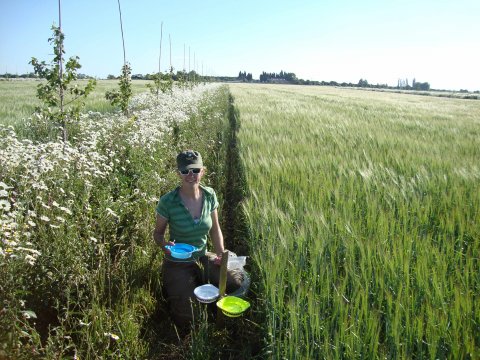Readers of this website and newsletter don’t need convincing that agroforestry is a more sustainable way of farming than monocultures, but that it is not yet clear to everyone. More empirical evidence about the benefits of agroforestry in modern temperate agriculture is thus urgently needed.
We investigated yields, biodiversity, pollination and carbon stocks in six UK alley-cropping sites over a three-year period, and compared these to adjacent monocultures. A first paper has recently been published in Agriculture Ecosystems and Environment on insect pollination, and other papers will appear soon.
We assessed insect pollination in two ways. First, we estimated the abundance and species richness of wild insect pollinators on the assumption that greater abundance or diversity would lead to more pollination services. Second, we placed potted California poppies, which do not occur naturally, in these fields and counted the number of seeds they produced as a direct measure of pollination services.
We found strong evidence that agroforestry has a positive impact on pollination. For example, agroforestry plots had twice as many solitary bees and hoverflies, and in arable systems 2.4 times more bumblebees, than monocrop plots. One year, the poppies produced 4.5 times more seed in the agroforestry than in the monocrop plots. And at 40% of the sampling units (sites-by-year), we counted an average of 10.5 times more solitary bee species!
The conclusion brooks no doubt: in the UK, alley-cropping agroforestry systems clearly support way more wild pollinating insects than monocultures. That’s good news for farmers, who need their pollination services; and for biodiversity.
The published paper is temporarily available on this site, and a preprint will be permanently available through CORE.
Funding for the PhD Research was provided by the University of Reading Research Endowment Trust Fund and the Organic Research Centre. Additional support was given by The Nineveh Charitable Trust.












